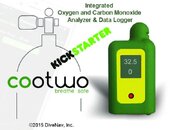There are 2 types of drift in an ElectroChemical sensor: zero reference (aka baseline) and span.
Your 0 ppm CO will be perfect to calibrate the baseline, but you will need something more than 0 to calibrate the span.
I'm pretty sure I understand two point calibrations (zero crossing and gain), but what is the difference with "calibrating" an O2 sensor in air?




